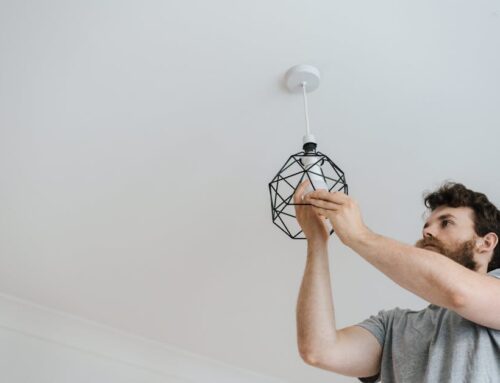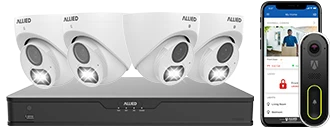Introduction to Home Monitoring Systems
Home monitoring systems are becoming increasingly popular as technology evolves and more homeowners seek to enhance their property security and convenience. These systems consist of various electronic devices and software designed to monitor different aspects of a home. They can include security cameras, sensors, alarms, and smart home integration, offering real-time surveillance and alerts through mobile apps or other interfaces.
The primary purpose of a home monitoring system is to provide peace of mind by ensuring the safety and security of a property. With advancements in technology, modern systems offer high-definition video, motion detection, and even facial recognition features. Users can monitor their property remotely, receive notifications of suspicious activities, and even interact with visitors or intruders via built-in speaker systems.
According to a report by MarketsandMarkets, the global home security systems market size was valued at USD 53.6 billion in 2020 and is projected to reach USD 78.9 billion by 2025, at a compound annual growth rate (CAGR) of 8.0%. This growth is driven by increasing awareness of home security, advancements in wireless technology, and the rising adoption of smart home devices.
Different brands and manufacturers offer various components for home monitoring systems, allowing homeowners to customize setups according to their needs. These can range from simple DIY installations with basic sensors to more complex professionally-installed systems with a suite of integrated security solutions.
The development of the Internet of Things (IoT) has greatly influenced home monitoring systems, leading to the creation of interconnected devices that can communicate with each other. This integration facilitates automation and enables users to control and monitor their home environment efficiently. For example, a smart home hub can integrate lighting, thermostats, and cameras, making it possible to manage all these elements from a single platform.
In summary, home monitoring systems offer a practical solution for enhancing home security through the use of advanced technologies and connectivity. As the market continues to grow and innovate, homeowners have access to more sophisticated tools to protect their property and loved ones.
Types of Home Monitoring Systems
Home monitoring systems have evolved to offer a variety of options that cater to different needs and preferences. Broadly, these systems can be categorized into several types, including security systems, environmental monitoring, and health monitoring systems.
Security systems are designed to protect homes from intrusions and unauthorized access. These usually include surveillance cameras, motion detectors, and alarm systems. Some advanced security systems also come with facial recognition technology and can be integrated with smart home devices for enhanced control.
Environmental monitoring systems focus on keeping the home environment safe and comfortable. These systems often include sensors that monitor air quality, temperature, humidity, and potential hazards such as carbon monoxide or radon gas. They can alert homeowners to changes in the environment that could affect health and safety.
Health monitoring systems are increasingly being used to assist with the care of elderly or disabled individuals. These may include devices that monitor vital signs, detect falls, and remind users to take medication. Some systems are even capable of alerting caregivers or medical professionals in the event of an emergency.
Each type of home monitoring system brings specific functionalities tailored to particular needs. Understanding the types of systems available can help homeowners make informed decisions about what is best for their household.
Key Features and Technology
When considering home monitoring systems, it is essential to understand the key features and technologies that define their functionality and effectiveness. These elements contribute to the comprehensive protection and ease of use of modern home security solutions.
Core Features
Home monitoring systems offer a variety of core features designed to enhance security and convenience. These features generally include:
- Motion Sensors: Detect movement within a specified area, triggering alerts or alarms when suspicious activity is detected.
- Video Surveillance: High-definition cameras offer real-time viewing and recording capabilities, often with night vision and wide-angle lenses.
- Entry Sensors: Placed on doors and windows to detect opening and closing, crucial for perimeter security.
- Smart Home Integration: Compatibility with other smart devices, such as lights, locks, and thermostats, creating a unified ecosystem.
- Remote Access: Access and control your system via smartphone applications, enabling monitoring and management from anywhere.
Advanced Technologies
Modern home monitoring systems leverage advanced technologies to provide enhanced security and user experience. Key technologies include:
- Artificial Intelligence (AI): Utilizes machine learning algorithms to differentiate between normal and suspicious activity, reducing false alarms.
- Internet of Things (IoT): Connects various devices within the home, allowing seamless communication and improved automation.
- Cloud Storage: Stores surveillance footage and system data on remote servers, ensuring data is securely backed up offsite.
- Encryption: Ensures all transmitted data, such as video feeds and sensor alerts, is protected from unauthorized access.
Comparison of Key Features
The following table provides a comparison of some essential features across various home monitoring systems:
| Feature | Description |
|---|---|
| Motion Sensors | Detects and alerts to movement in monitored areas. |
| Video Surveillance | Real-time viewing, recording, night vision, and wide-angle lenses. |
| Entry Sensors | Monitors doors and windows for unauthorized entry. |
| Smart Home Integration | Compatible with other smart home devices for cohesive control. |
| Remote Access | Ability to control and monitor the system from a smartphone app. |
Understanding these features and technologies is crucial when selecting a home monitoring system. Evaluating the relevance and necessity of each element can help customize the system to meet specific security needs and preferences.
Benefits and Drawbacks
Home monitoring systems offer a range of benefits and drawbacks that potential users should consider before making a decision.
Benefits:
- Enhanced Security: Home monitoring systems provide real-time surveillance and alerts, increasing the security of your property. They can help deter burglars, as visible cameras and alarms act as a deterrent.
- Remote Monitoring: Many modern systems allow users to monitor their homes remotely via smartphones or other devices. This is particularly useful for frequent travelers or those with second homes.
- Emergency Response: Advanced systems can be connected to emergency services, ensuring a quick response in case of fire, break-ins, or medical emergencies.
- Insurance Benefits: Installing a home monitoring system can reduce home insurance premiums, as it lowers the risk of theft and damage.
- Energy Management: Some systems include features to control lighting, heating, and other utilities, leading to energy savings and increased convenience.
- Peace of Mind: Knowing that your home is being monitored provides peace of mind, reducing stress and anxiety about potential security breaches.
Drawbacks:
- Cost: The initial purchase and installation costs can be high, and there may be ongoing subscription fees for certain services.
- Privacy Concerns: Surveillance systems can raise privacy issues, as they involve continuous monitoring and recording of activities in and around the home.
- Technical Issues: Home monitoring systems rely on technology that can malfunction or be susceptible to hacking attempts. Ensuring system reliability and security is an ongoing concern.
- Complexity: Some systems can be complex to install and use, requiring professional installation or a steep learning curve for the users.
- Dependency on Power and Internet: Many systems depend on electricity and internet connectivity, which means they may not function during power outages or internet service disruptions.
- False Alarms: False alarms can occur, causing unnecessary stress and potentially resulting in fines or charges for emergency service responses.
When evaluating home monitoring systems, it is essential to weigh these benefits and drawbacks to determine whether such a system is appropriate for your needs and circumstances. Being informed about both sides ensures that users make a balanced and well-considered decision.
Market Trends and Innovations
The landscape of home monitoring systems is rapidly evolving due to advancements in technology and changing consumer demands. Understanding the current market trends and innovations is crucial for anyone considering the purchase of a home monitoring system.
Artificial Intelligence and Machine Learning
Artificial Intelligence (AI) and Machine Learning (ML) have made significant inroads in home monitoring systems. These technologies enable devices to learn from user behavior and adapt over time, leading to more accurate and efficient monitoring. AI-powered systems can identify unusual activities and send alerts, thereby enhancing security measures. For example, AI can distinguish between an intruder and a family member or pet, reducing false alarms.
Integration with Smart Home Ecosystems
Many home monitoring systems are now designed to integrate seamlessly with broader smart home ecosystems. This integration allows for central control through platforms like Amazon Alexa, Google Assistant, and Apple HomeKit. Users can manage all their smart home devices, including security cameras, lights, and thermostats, from a single interface, improving convenience and connectivity.
Advancements in Sensor Technology
Sensor technology has seen notable advancements, contributing to the effectiveness of home monitoring systems. Modern sensors are more sensitive and accurate, capable of detecting minute changes in the environment such as motion, sound, and temperature. Enhanced sensor technology ensures timely and precise alerts, improving the overall reliability of the system.
Cloud Storage and Data Analytics
The shift towards cloud storage has revolutionized how data is stored and accessed in home monitoring systems. Cloud storage offers several advantages, such as remote access to footage and the ability to store large amounts of data without the need for local hardware. Additionally, data analytics tools can process the collected data to provide insights and reports, helping users optimize their home security arrangements.
Wireless and Battery-Powered Devices
Wireless technology significantly enhances the flexibility and ease of installation for home monitoring systems. Battery-powered devices eliminate the need for extensive wiring, making installation less intrusive and more cost-effective. Innovations in battery technology also mean longer battery life, reducing the frequency of replacements and maintenance.
Enhanced User Interfaces
Modern home monitoring systems come with improved user interfaces, both in terms of mobile applications and web platforms. These interfaces are designed to be user-friendly, offering intuitive controls and easy access to system settings and alerts. Improved UIs ensure that users can efficiently monitor their homes without needing extensive technical knowledge.
These trends and innovations indicate a growing emphasis on smarter, more integrated, and user-friendly home monitoring solutions. As technology continues to advance, the capabilities and performance of these systems are expected to improve, offering homeowners even greater control and peace of mind.
Choosing the Right Home Monitoring System
When selecting a home monitoring system, it is crucial to assess various factors to ensure that the chosen system meets your specific needs and preferences. Here are some key considerations to keep in mind:
1. Purpose and Requirements:
Consider what you aim to achieve with a home monitoring system. Are you looking for general security, or do you require specific features such as fire detection, carbon monoxide monitoring, or baby monitoring? Knowing your primary needs will help narrow down your options.
2. Compatibility:
Ensure that the home monitoring system is compatible with your existing devices and infrastructure. Some systems may integrate seamlessly with smart home devices like Amazon Alexa, Google Home, or Apple HomeKit, while others may require additional setup or components.
3. Ease of Installation and Use:
Evaluate whether the system requires professional installation or if it offers a DIY option. Systems that are easy to install and configure may save time and cost. Additionally, consider the user interface of the system’s app or control panel. A user-friendly interface can significantly enhance your experience.
- * Easy to Install
- * User-friendly Interface
- * Professional Installation Required
4. Monitoring Options:
There are different monitoring options available, such as self-monitoring or professional monitoring. Self-monitoring systems send notifications directly to your smartphone, while professionally monitored systems alert a monitoring center that can dispatch emergency services if needed.
5. Costs:
Analyze both the initial investment and ongoing costs. This includes equipment costs, installation fees, subscription fees for professional monitoring, and any additional charges for extra services or features.
6. Smart Features:
Many modern home monitoring systems come with smart features such as remote access, real-time alerts, video streaming, and automation capabilities. Assess which smart features are important to you and ensure the system supports them.
7. Reliability and Reputation:
Research the reliability and reputation of the home monitoring system and its manufacturer. Check user reviews, expert ratings, and industry awards to gauge the system’s performance and customer satisfaction levels.
Below is a comparison table summarizing some crucial factors when choosing a home monitoring system:
| Factor | Description |
|---|---|
| Purpose | General security, fire detection, baby monitoring, etc. |
| Compatibility | Integration with smart home devices and existing infrastructure. |
| Installation | DIY vs. professional installation requirements. |
| Monitoring | Self-monitoring vs. professional monitoring options. |
| Costs | Initial and ongoing costs (equipment, installation, subscription). |
| Smart Features | Remote access, real-time alerts, video streaming. |
| Reliability | User reviews, expert ratings, manufacturer reputation. |
Finding the right home monitoring system involves a careful balance between features, costs, and your specific needs. By thoroughly evaluating these factors, you can make an informed decision that enhances your home’s security and ensures peace of mind.












